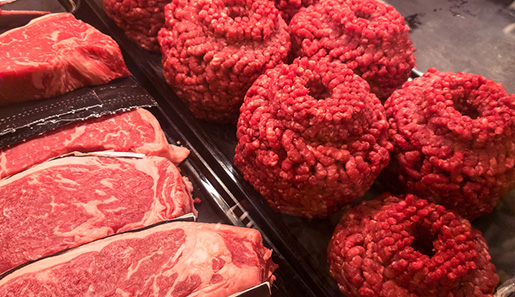 |
|
SPOTLIGHT |
|
|
|
|
|
| Where’s the Beef? |
With consumers’ growing interest in grass-fed, hormone free meat, those of us who live in Hawaii are fortunate that Molokai Livestock Cooperative and Hawaii Beef Producers enable local ranchers to bring their 100% grass-fed, hormone and antibiotic-free beef to market. Molokai Livestock Cooperative works with 12 Molokai ranches and supplies ground beef to our Foodland stores on Oahu. Hawaii Beef Producers works with more than 50 individual ranchers and maintains its own herds to supply steaks, other whole cuts, and ground beef to our Big Island — and select Oahu — stores. Because both organizations handle far fewer cattle than mainland plants, these local entities are able to produce high quality meat through a thoughtful and respectful process.
“Hawaii is a great place to raise cattle,” says Jack Spruance, general manager of Molokai Livestock Cooperative. “The cattle eat grass and Hawaii is a climate that can grow grass year-round. We’re not importing it, we’re growing it,” he says. Producing the best beef requires stewarding the land carefully. Hawaii Beef Producers’ Jill Mattos, a fourth generation rancher, explains that cattle is rotated through pastures every two days to provide the best grazing and allow the land to regenerate.
Here’s some information to “beef up” your knowledge of local grass-fed beef:
|
Grass is Greener: Grass-fed cattle have spent their entire lives eating grass, just as nature intended. As a result, the cattle don’t have the disease complications of cattle sent to feed lots to be fattened on grain until they hit market weight.
Better for You: Grass-fed beef is leaner and has fewer calories than grain-fed beef. It is rich in antioxidant vitamin E and health enhancing fats, while being low in fats linked to obesity, diabetes, and cardiovascular disease.
Center of Attention: Shoppers often ask why the beef in the center of their bright red ground beef is duller and less red in color. There is no need for concern. As Jill explains, “Exposure to oxygen causes the beef to bloom red; it’s dull in color when there’s no oxygen,” like in the center of the package.
Cook to Perfection: Both Jill and Jack are adamant that Hawaii beef should not be overcooked. “Medium or medium rare,” suggests Jill, otherwise “it will get chewy.”

|
|
|
|
| Did You Know? |
 |
 |
| The first cattle in Hawaii were brought as a gift to Kamehameha I by Captain George Vancouver in 1793.This gift has made a major impact on Hawaii’s economy and spawned a rich tradition of paniolo and ranch culture that continues today. |
| Photo courtesy of Hawaii Beef Producers |
|
|
|
|
 |
|
RECIPES |
|
|
|
|
|
| Local Ground Beef and Watercress |
| Serves 4 |
|
|
|
| This classic plantation-style dish is full of rich umami flavor. It’s so simple to make—perfect for a weeknight dinner for busy families! |
| INGREDIENTS |
- 2 tablespoons vegetable oil
- ½ cup minced onion
- 1 pound local ground beef
- 1 teaspoon garlic salt
- 1 tablespoon chopped fresh ginger
- 1 tablespoon sugar
- 2 teaspoons fish sauce
- ½ bunch fresh watercress, cut into 1 inch pieces
- 1/4 cup shoyu
- 1 block firm tofu, cut into ¾-inch pieces
|
| INSTRUCTIONS |
- In a heavy-gauge pot, heat the vegetable oil.
- Add the onions and cook until translucent. Add the ground beef, breaking it up into small pieces, and cook until browned.
- Season with garlic salt. Add ginger, sugar and fish sauce, and stir together.
- Add the watercress and allow it to wilt.
- Add the shoyu and simmer for 3 minutes.
- Stir in the tofu and allow to warm through.
- Adjust seasoning. Serve with hot rice.
|
|
 |
| Did you make this recipe? |
| Let us know how it turned out for you! Share a picture on Instagram with the hashtag #FoodlandEatLocal |
|
| How can you tell it’s local? |
| Look for the ORANGE SIGNS |
| to find locally grown and locally made items throughout our stores. |
|
|
|
|
|
|
|

